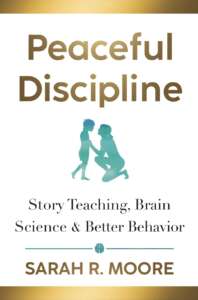
Sign in
Don't have an account with us? Sign up using the form below and get some free bonuses!

Holding space for our children's big feelings is no easy task -- and there's good reason for that. According to research in the field of interpersonal neurobiology, we're "wired" to pick up each other's feelings. That's right -- emotions are actually proving to be contagious.
Ever wondered why you start to tear up when someone you love is crying? Or why your heart leaps for joy when your best friend shares some wonderful news? Mirror neurons are actually telling you to feel what others are expressing. Perhaps we're not "too sensitive" after all -- this is simply brain science at work!
Knowing a bit about how the brain works, it's no surprise that when our kids are dysregulated, it's tempting to be pulled into their emotional storm.
That may be part of the reason adults are often quick to want to “fix” our children’s feelings; to stop the crying; to calm the tantrum; to just make the discomfort STOP somehow. Our desire usually comes from a place of great compassion and empathy--although it can also come from our own place of discomfort.
While our intentions are good, it’s important to remember what happens when we stuff our feelings inside. We know very well what it’s like when someone we love doesn’t let us process our feelings fully; we feel unheard and invalidated. If no one's been holding space for us, we recognize that empty feeling of not having the closure we seek after being distraught.
As hard as it is, it’s critical that we let our children get ALL their stress out

completely. This process is often referred to as “holding space” for feelings. In short, it means that more than just “allowing” it, we consciously welcome children to express themselves without judgment until they naturally find their way back to peace. It’s an important part of the co-regulation process.
Daniel J. Siegel, M.D. and Tina Payne Bryson, Ph.D. support this idea in their work around attachment theory. In The Power of Showing Up, they cover the "4 Ss" of secure attachment: children need to feel Safe, Seen, Soothed, and Secure. Holding space for their feelings can certainly be part of this ever-important equation.
I’m going to focus on what most people call tantrums since those tend to feel the messiest to navigate alongside our children.

I prefer to call a tantrum an “emotional release” because that’s exactly what’s happening -- all those big feelings are coming out (albeit often like a freight train).
Why do I change the verbiage? I do it largely because it’s helpful (and frankly, easier) to remember that emotional release is a healthy and beneficial process with long-term protective benefits. It’s easier to have compassion and empathy for someone who’s expressing themself, than it is for someone who’s “throwing a tantrum.” Equally concerning is “meltdown” -- it connotes losing control rather than releasing pent-up stress.
Furthermore, we tend to think of tantrums as being limited to toddlers, when in reality, there are many versions of tantrums that aren’t age-specific. Perhaps it’s the older child who launches into a yelling tirade when they don’t get their way; perhaps it’s the angsty tween or tween who says unkind words and storms off.
Even adults sometimes have their own versions of tantrums. We slam doors. We yell when we don’t mean to. We explode at those we love and say things we later regret.
Everyone “blows up” or “loses it” sometimes. Those are all adult-sized tantrums and seemingly have no expiration date unless the adult finds healthier coping strategies.
You may also like: Is a Calm Down Corner Better than a Time-Out?
If we can reframe the way we think about tantrums, and reframe who we believe has them, we’re more likely to welcome those big feelings when they come from those whose brains aren’t even capable of fully processing those big feelings, much less controlling their impulses, on their own yet. Holding space is easier when you see the "whole child" as you'd honor and respect any other human who's struggling. The only difference may be in how they're expressing their hurt.
Impulse control and emotional regulation are part of executive function, which comes from a part of the brain that doesn’t mature until around age 25 (the prefrontal cortex). If a young child feels urgently compelled to scream, they simply do. It’s loud, but it can also be quite developmentally appropriate. (And yes, we can work with them on this.)
If your child is expressing their feelings in a big way and you're having trouble holding space for them, look within. This is where we get to re-parent ourselves and ask questions like:
Looking within can be enlightening, albeit sometimes very difficult, work. If we find that perhaps we weren't free to express ourselves when we were younger, we may discover a pattern we'd like to change for our own children. Know that it's normal for feelings of stress and anxiety to rise up when we're working through this process.
Oftentimes, it's simply a matter of co-regulating with our child. Being still with them; not offering solutions, but actively listening. Being peaceful.
We might say something like, "All your feelings are safe here." Not only is that a reminder to them, but it also helps us to keep still and breathe through our own feelings alongside our child.
And perhaps as you're holding space for your child in a whole new way, you'll be able to give yourself some empathy, too. This is hard and important work.
You can find more ideas about ways to support your child's big feelings here: Holding Space for Big Feelings (mini-course).
If you've been holding space and the child seems to be genuinely stuck on the same points for a long time, they might need help moving on to the next phase of their emotional expression.
How long is long? There’s no set amount of time, unfortunately -- wouldn’t it be nice if there were? Emotions resolve at their own pace. Trust your judgement and read your child’s cues.
What kind of cues might the child be offering you that holding space isn't what they need anymore?
Perhaps they’re seeking regular eye contact and seemingly looking for guidance; perhaps they verbalize, “I don’t know what to do” or “Make it stop!” Some children change their tone of voice and the expression has become more of a tired / bored sound. If they're tired or bored, they'll be more likely to loop emotionally -- and nothing will "solve" the looping until they're rested or otherwise supported.
Every child has their own way of asking for additional support.
They may also hit, push, or act out more physically. Recall in these moments that this behavior is a reflection of their internal discomfort. Keep yourself and others safe, stay grounded as best you can, and gently but directly remind them that “[Hitting, etc.] hurts. Hold your body still and I’ll help you get through this.”
When you observe counterproductive behavior, it’s alright to offer statements that might be helpful.
If holding space isn't enough and moving on isn't happening naturally, that's often a child's way to say they need a different approach.
Refrain from solving the child’s problem for them, but you can certainly express your curiosity. “I wonder…” statements can prove especially useful here.
Examples:
Many children are not receptive to being asked questions when they’re upset, which is another reason I prefer the “I wonder” statements. They can choose whether and how to respond.
Let your child process fully and when they’re ready, you can move on together. The tantrum will have fully resolved.
There are no leftovers; there’s no accumulated stress to save for the next big emotional release.
Every step you take towards supporting your child, and allowing them to fully express themself while you're holding space for them, gives the child one less hurt from which to heal once they're older. There's great peace in that for all of us.
